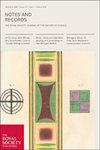Analysis and demonstration: Wallis and Newton on mathematical presentation
IF 0.6
3区 哲学
Q3 HISTORY & PHILOSOPHY OF SCIENCE
Notes and Records-The Royal Society Journal of the History of Science
Pub Date : 2018-10-17
DOI:10.1098/rsnr.2018.0025
引用次数: 3
Abstract
Emulating the Greek geometers, Newton used synthetic demonstration to present the ground-breaking arguments of the Principia. This paper argues that we can better understand Newton's reasons for using geometry by considering John Wallis's interpretation of synthetic demonstration. Wallis condemned demonstration for failing to explain the mathematical truths it presented. He opposed to it a presentation that combined symbolic analysis with a documented account of discovery. In preferring symbols, Wallis was motivated both by the nascent tradition of symbolic analysis and by contemporary interest in artificial languages. Newton maintained Wallis's characterization of Greek demonstration as adapted to common understanding rather than as strictly elucidating, but he inverted the values Wallis associated with synthesis and analysis. In Newton's new account, synthetic demonstration was preferable precisely because it could address inexpert readers without exposing them to the complications of symbols-based analysis. Newton advanced his arguments on behalf of geometry through portraits of ancient mathematicians: Archimedes and Pythagoras.分析与论证:沃利斯和牛顿的数学表示
牛顿模仿希腊几何学家,用综合论证提出了《原理》的开创性论点。本文认为,通过考察约翰·沃利斯对综合论证的解释,我们可以更好地理解牛顿使用几何的原因。沃利斯谴责论证不能解释它所呈现的数学真理。他反对将符号分析与发现的记录相结合。沃利斯之所以偏爱符号,是受到了新生的符号分析传统和当代对人工语言的兴趣的推动。牛顿坚持认为,沃利斯对希腊论证的描述适应于普遍理解,而不是严格的阐释,但他颠覆了沃利斯与综合和分析相关联的价值观。在牛顿的新描述中,综合论证更可取,正是因为它可以解决不专业的读者,而不会让他们接触到基于符号的分析的复杂性。牛顿通过古代数学家阿基米德和毕达哥拉斯的肖像为几何学提出了自己的论点。
本文章由计算机程序翻译,如有差异,请以英文原文为准。
求助全文
约1分钟内获得全文
求助全文
来源期刊
CiteScore
1.50
自引率
0.00%
发文量
45
审稿时长
>12 weeks
期刊介绍:
Notes and Records is an international journal which publishes original research in the history of science, technology and medicine.
In addition to publishing peer-reviewed research articles in all areas of the history of science, technology and medicine, Notes and Records welcomes other forms of contribution including: research notes elucidating recent archival discoveries (in the collections of the Royal Society and elsewhere); news of research projects and online and other resources of interest to historians; essay reviews, on material relating primarily to the history of the Royal Society; and recollections or autobiographical accounts written by Fellows and others recording important moments in science from the recent past.

 求助内容:
求助内容: 应助结果提醒方式:
应助结果提醒方式:


